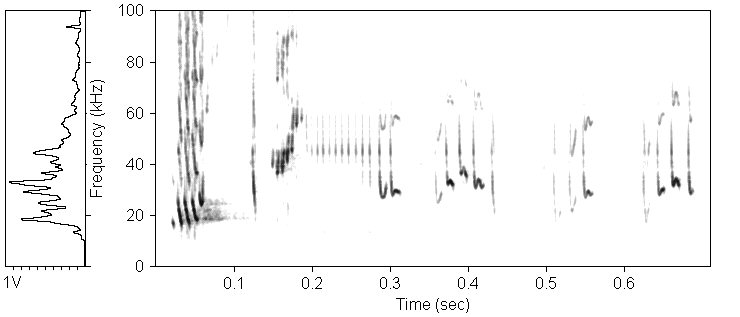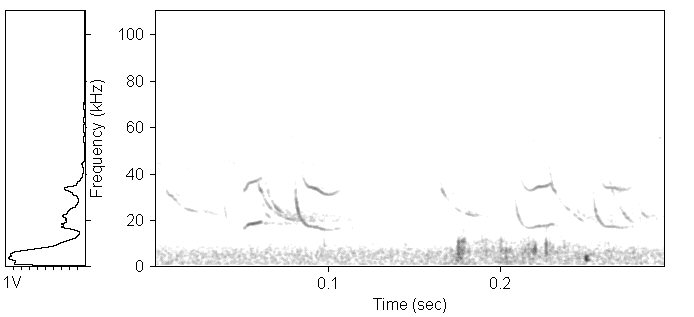Social calls The social calls of bats are often very useful for identifying bat species as they are often species-specific. Recordings of social calls, are usually only useful if they are recorded using a time expansion or full spectrum bat detector. A few Nathusius' pipistrelle social calls are presented here. |
 |
| Male Nathusius' pipistrelle establish territories and defend them from other males. They emit a social call, nearly always from a roost (i.e. when they're stationary) for long periods of time. For example, males observed in Northern Ireland call throughout the entire night coming out to feed only when the sun was just rising and the majority of other bats had returned to their roosts. (See a video clip of a male Nathusius' calling from his roost). The social calls are very complex (see above). Recordings usually show just the first part of this call (0-0.2s) as the other part is much quieter. Occasionally this part of the call is produced on the wing early in the active period. . |
 |
Calls recorded from a roost during the period of early lactation. Presumably these calls are emitted by juveniles. Note the the frequency of maximum energy (19.5 khz) is half that of the echolocation calls of the adults (39kHz).
|
| Distress calls may be heard from bats held on the hand and are very harsh. They may attract other individuals and species which perform mobbing behaviour. |
|
Nathusius' pipistrelle in Great Britain and Ireland
subglobal1 link | subglobal1 link | subglobal1
link | subglobal1 link | subglobal1 link | subglobal1
link | subglobal1 link
subglobal2 link | subglobal2 link | subglobal2
link | subglobal2 link | subglobal2 link | subglobal2
link | subglobal2 link
subglobal3 link | subglobal3 link | subglobal3
link | subglobal3 link | subglobal3 link | subglobal3
link | subglobal3 link
subglobal4 link | subglobal4 link | subglobal4
link | subglobal4 link | subglobal4 link | subglobal4
link | subglobal4 link
subglobal5 link | subglobal5 link | subglobal5
link | subglobal5 link | subglobal5 link | subglobal5
link | subglobal5 link
subglobal6 link | subglobal6 link | subglobal6
link | subglobal6 link | subglobal6 link | subglobal6
link | subglobal6 link